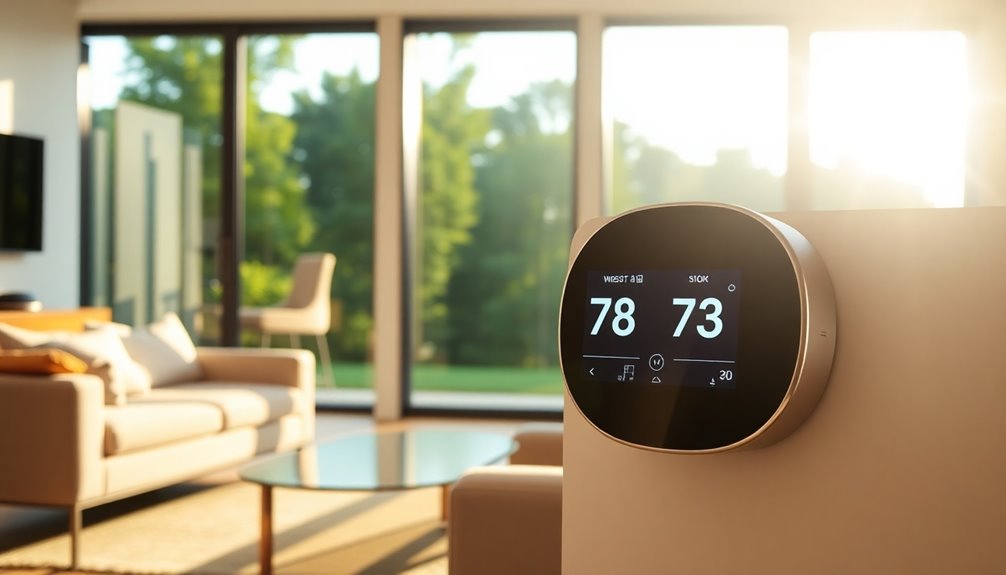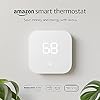If you're looking for the best smart thermostats of 2025, consider options like the Amazon Smart Thermostat, Sensi Smart Thermostat (ST55), and Google Nest Thermostat. These models are energy-efficient and user-friendly, often reducing your energy bills. The Honeywell Home RTH6580WF offers flexible programming, while the Emerson Sensi Touch features a vibrant touchscreen. Each thermostat has unique benefits, like integration with Alexa or Google Assistant for easy control. Their ENERGY STAR certification means you'll save money annually. Stick around to discover more details about their features and how they can fit your home.
Amazon Smart Thermostat – Works with Alexa and Ring
Amazon Smart Thermostat – Save money and energy - Works with Alexa and Ring - C-wire required
$79.99 (as of October 24, 2025 20:53 GMT +00:00 - More infoProduct prices and availability are accurate as of the date/time indicated and are subject to change. Any price and availability information displayed on [relevant Amazon Site(s), as applicable] at the time of purchase will apply to the purchase of this product.)If you're looking for an affordable and efficient way to manage your home's temperature, the Amazon Smart Thermostat is an excellent choice. Priced at just $60, it integrates seamlessly with Alexa and Ring, allowing you to control your home's climate through voice commands or the Alexa app. This ENERGY STAR certified device can help you save around $50 annually on energy bills. Installation is straightforward, typically taking 30-60 minutes, and you can use basic tools like a hammer and drill. Once set up, you can easily schedule temperature settings and monitor air quality using compatible devices. While some users report minor connectivity issues, the overall experience is positive, making this thermostat a smart addition to any home.
Best For: Budget-conscious homeowners looking for an easy-to-install smart thermostat that integrates with Alexa and Ring.
Pros:
- Affordable price at $60, with potential rebates from local energy providers.
- ENERGY STAR certified, leading to average annual savings of $50 on energy bills.
- Simple installation process, taking only 30-60 minutes with basic tools.
Cons:
- Some users report connectivity issues after power outages.
- Basic scheduling capabilities may limit customization for temperature settings.
- Voice command functionality can be inconsistent, with certain commands not being recognized effectively.
Sensi Smart Thermostat (ST55)
Sensi Smart Thermostat, 100 Years Of Expertise, Wi-Fi, Data Privacy, Programmable, Easy DIY Install, Works With Alexa, Energy Star Certified, Mobile App, ST55
(as of October 24, 2025 20:53 GMT +00:00 - More infoProduct prices and availability are accurate as of the date/time indicated and are subject to change. Any price and availability information displayed on [relevant Amazon Site(s), as applicable] at the time of purchase will apply to the purchase of this product.)The Sensi Smart Thermostat (ST55) stands out as an ideal choice for homeowners seeking an easy-to-install, energy-efficient solution for managing their HVAC systems. With over 100 years of HVAC expertise, this thermostat offers Wi-Fi connectivity and is Energy Star certified, ensuring you save about 23% on HVAC energy costs. You'll appreciate its programmable scheduling and user-friendly mobile app for remote access. Installation is a breeze, thanks to the built-in level and step-by-step app instructions—no common wire is needed for most setups. Plus, it's compatible with Amazon Alexa, Google Assistant, and SmartThings. While it has minor limitations, like basic usage reporting, the Sensi Smart Thermostat delivers excellent performance and user satisfaction, making it a top contender in smart home technology.
Best For: Homeowners looking for an easy-to-install, energy-efficient thermostat with remote access capabilities.
Pros:
- Easy DIY installation with built-in level and step-by-step app instructions.
- Wi-Fi connectivity allows for remote control through a user-friendly mobile app.
- Energy Star certified, potentially saving about 23% on HVAC energy costs.
Cons:
- Limited compatibility with Bixby voice assistant.
- Basic usage reporting may not meet all user expectations.
- Occasional need for setting adjustments can be inconvenient for some users.
Google Nest Thermostat – Smart Wifi Thermostat for Home
Google Nest Thermostat - Smart Thermostat for Home - Programmable Wifi Thermostat - Snow
20% OffFor homeowners seeking energy efficiency without sacrificing comfort, the Google Nest Thermostat stands out as a top choice. This ENERGY STAR certified device is a smart, programmable Wi-Fi thermostat designed to optimize energy use and maintain your home's comfort. You can control it remotely using your phone, tablet, or laptop, and it integrates seamlessly with Google Assistant and Matter-certified voice assistants. While installation is generally straightforward, some may need a C wire for full functionality. Once set up, it learns your preferences and adjusts temperatures accordingly, but be aware of potential connectivity issues, especially with Alexa. Many users praise its energy-saving capabilities, although some express frustration over installation challenges. Overall, it's a solid option for tech-savvy homeowners.
Best For: Homeowners looking for a smart thermostat that enhances energy efficiency and offers remote control features.
Pros:
- ENERGY STAR certified, promoting energy savings and efficiency.
- Remote access via mobile devices for convenient temperature management.
- Learns user preferences to optimize heating and cooling automatically.
Cons:
- Installation may require a C wire for some systems, complicating setup.
- Connectivity issues reported, particularly with Alexa integration.
- Mixed reviews on installation ease, with some users finding it challenging.
Honeywell Home RTH6580WF Wi-Fi 7-Day Programmable Thermostat
Honeywell Home RTH6580WF Wi-Fi 7-Day Programmable Thermostat, White
Looking to streamline your home's energy management? The Honeywell Home RTH6580WF Wi-Fi 7-Day Programmable Thermostat is a fantastic choice. This ENERGY STAR certified device helps you save energy by providing monthly reports and personalized tips. With flexible programming, you can set schedules for 7 days with up to 4 periods each day, matching your lifestyle perfectly. It connects to Wi-Fi, allowing you to control it remotely through the Total Connect Comfort or Resideo app—no matter where you are. The user-friendly design features a big, backlit display, and installation is straightforward, requiring a C-wire. Rated 4.3 out of 5 stars, customers appreciate its ease of use and reliable performance, ensuring you manage your heating and cooling efficiently.
Best For: This thermostat is best for homeowners looking for an energy-efficient solution that offers remote control and flexible scheduling for optimal comfort.
Pros:
- ENERGY STAR certified, providing energy savings and monthly usage reports.
- Compatible with voice assistants, allowing for hands-free control and convenience.
- User-friendly design with a large backlit display, making it easy to read and operate.
Cons:
- Requires a C-wire for installation, which may necessitate additional wiring for some homes.
- Some users desire more control features, such as the ability to lock thermostat settings.
- Initial setup requires creating an online account, which may be a barrier for less tech-savvy individuals.
Emerson Sensi Touch Wi-Fi Smart Thermostat (ST75)
Emerson Sensi Touch Wi-Fi Smart Thermostat with Touchscreen Color Display, Works with Alexa, Energy Star Certified, C-wire Required, ST75 Black 5.625" x 3.4" x 1.17"
12% OffEmerson Sensi Touch Wi-Fi Smart Thermostat (ST75) stands out for tech-savvy homeowners who want seamless control over their home's climate. With its sleek, modern design and a vibrant touchscreen display, you can easily read temperatures and navigate intuitive menus. Installation is a breeze, thanks to the built-in level and step-by-step app instructions, making it compatible with most HVAC systems. This ENERGY STAR certified thermostat helps you save about 23% on energy costs with features like flexible scheduling and remote access via the Sensi app. You can control it from anywhere and integrate it with smart home systems like Alexa and Google Assistant. Plus, with a reliable warranty and solid customer support, you're well taken care of.
Best For: Tech-savvy homeowners seeking seamless control and energy efficiency in their HVAC systems.
Pros:
- ENERGY STAR certified, potentially saving about 23% on HVAC energy costs.
- Easy DIY installation with step-by-step app instructions and built-in level.
- Compatible with popular smart home systems like Alexa, Google Assistant, and Apple HomeKit.
Cons:
- Some users experience Wi-Fi connectivity challenges, particularly with certain routers.
- Requires a common wire (C-wire) for operation, which may not be available in all homes.
- Installation guidance may be necessary for some users, as noted in customer reviews.
Factors to Consider When Choosing Smart Thermostats
When you're choosing a smart thermostat, several factors can greatly impact your decision. You'll want to consider energy efficiency ratings, installation complexity, and compatibility with your existing systems. Additionally, think about remote control features, price, and any available incentives that could help you save money.
Energy Efficiency Ratings
Choosing a smart thermostat can feel overwhelming, but understanding energy efficiency ratings simplifies the process. One key rating to look for is the ENERGY STAR certification. This indicates that the thermostat meets strict energy efficiency guidelines set by the U.S. Environmental Protection Agency. By opting for an ENERGY STAR certified model, you could save around $50 annually on your energy bills through optimized heating and cooling schedules.
Additionally, many smart thermostats offer usage reports and energy-saving tips. These features help you identify your usage patterns and adjust settings for enhanced efficiency. Some models even claim to save as much as 23% on HVAC energy costs by allowing flexible scheduling and remote access to adjust temperatures based on occupancy.
Lastly, consider participating in utility programs that provide additional savings or rebates for using energy-efficient devices. This can boost the overall cost-effectiveness of your smart thermostat. By focusing on energy efficiency ratings and features, you'll make a well-informed choice that not only benefits your wallet but also contributes to a greener environment.
Installation Complexity
Installing a smart thermostat can be a straightforward task or a challenging one, depending on the model you select. Some models are designed for easy DIY installation, while others may require professional help. When considering a thermostat, it's crucial to check if it needs a common wire (C-wire) for operation. If your home doesn't have one, installation could get more complicated.
Many smart thermostats come with step-by-step app instructions that simplify the setup process. However, some models might have unclear documentation, leading to confusion and extra time spent on installation. On average, you might spend anywhere from 30 minutes to several hours installing your new device, depending on your experience and the specific requirements of the thermostat.
Before making your choice, you should also evaluate compatibility with your existing HVAC system. Certain systems may have unique installation needs that could complicate the setup. By keeping these factors in mind, you'll be better prepared to select a smart thermostat that fits your needs and ensures a smoother installation process.
Compatibility With Systems
How do you ensure your new smart thermostat will work seamlessly with your existing HVAC system? Start by checking the compatibility with your specific heating and cooling setups, like boilers, air conditioners, heat pumps, and furnaces. Not all smart thermostats are built the same, and some might not function correctly with your system.
Additionally, consider whether your chosen model requires a common wire (C-wire). While many smart thermostats can operate without one, certain features may depend on having a C-wire for optimal performance.
Don't forget to look into compatibility with smart home ecosystems such as Amazon Alexa, Google Assistant, and Apple HomeKit. This can significantly enhance your thermostat's functionality and ease of control.
Lastly, pay attention to any special requirements, like Wi-Fi connectivity specifications, to ensure seamless operation and remote access capabilities. By carefully evaluating these factors, you'll avoid installation headaches and set yourself up for an efficient, user-friendly experience with your new smart thermostat.
Remote Control Features
One key factor to consider when evaluating smart thermostats is their remote control features, which can greatly enhance your home's comfort and energy efficiency. Many smart thermostats offer dedicated mobile apps that let you adjust settings from your smartphone, tablet, or laptop, providing you with unmatched convenience and flexibility.
With these remote control capabilities, you can schedule temperature changes and make real-time adjustments based on your occupancy and personal preferences. Some models even integrate with voice assistants, allowing you to change settings using simple voice commands—making it even easier to manage your environment.
However, keep in mind that connectivity issues can affect the effectiveness of these features. A stable internet connection is crucial for consistent communication between the thermostat and your devices. Additionally, many smart thermostats send alerts and notifications through their apps, keeping you informed about temperature changes, maintenance reminders, and energy usage. This added layer of remote management helps you stay on top of your heating and cooling systems, ensuring optimal performance and efficiency throughout your home.
Price and Incentives
Affordability plays a crucial role in selecting the right smart thermostat for your home. Smart thermostats come in a wide range of prices, with budget-friendly options available for as low as $60, making them accessible to many consumers. While the initial cost matters, consider the potential savings too. Many ENERGY STAR certified models can save you an average of $50 annually on energy costs, which can help offset that initial investment over time.
Additionally, local energy providers often offer rebates or incentives for purchasing smart thermostats. You might even find some users who've received smart thermostats for free or at significantly reduced prices after applying for these rebates. These financial incentives can substantially lower your overall costs.
When evaluating your options, remember to consider the total cost of ownership. Factor in the potential savings from energy efficiency along with the purchase price and any available rebates. Doing so will give you a clearer picture of what you can afford and how quickly you can recoup your investment. By keeping these aspects in mind, you'll be better equipped to make an informed decision that fits your budget and energy-saving goals.
Frequently Asked Questions
What Is the Average Lifespan of a Smart Thermostat?
A smart thermostat typically lasts around 5 to 10 years, depending on usage and maintenance. Regular updates can extend its functionality, but you should consider replacing it if you notice performance issues or compatibility concerns.
Can Smart Thermostats Be Installed Without Professional Help?
Sure, you could install a smart thermostat yourself—if you're into playing electrical engineer. With some basic tools and a bit of courage, you can skip the professional help and dive into DIY adventures. Good luck!
How Do Smart Thermostats Improve Energy Efficiency?
Smart thermostats optimize your heating and cooling by learning your habits, adjusting temperatures automatically, and providing energy usage reports. They help you save money on bills while keeping your home comfortable and efficient.
Are Smart Thermostats Compatible With Older Heating Systems?
Imagine your vintage heater humming softly as you check a sleek smart thermostat on the wall. Yes, many smart thermostats work with older systems, but you should verify compatibility before making your upgrade.
Do Smart Thermostats Work With Mobile Data When Away From Home?
Yes, smart thermostats can work with mobile data when you're away from home. You can adjust settings, check temperatures, and monitor energy usage remotely using your smartphone, ensuring your home's comfort is always within reach.
Conclusion
In choosing the right smart thermostat, you're not just investing in comfort but also in energy efficiency and savings. Coincidentally, the best options on the market, like the Amazon Smart Thermostat and Google Nest, seamlessly blend technology with user-friendliness. As you explore these smart choices, remember that the right thermostat can adapt to your lifestyle, just as you adapt to the changing seasons. So, pick one that fits your home and enjoy a cozy, efficient living environment.




























